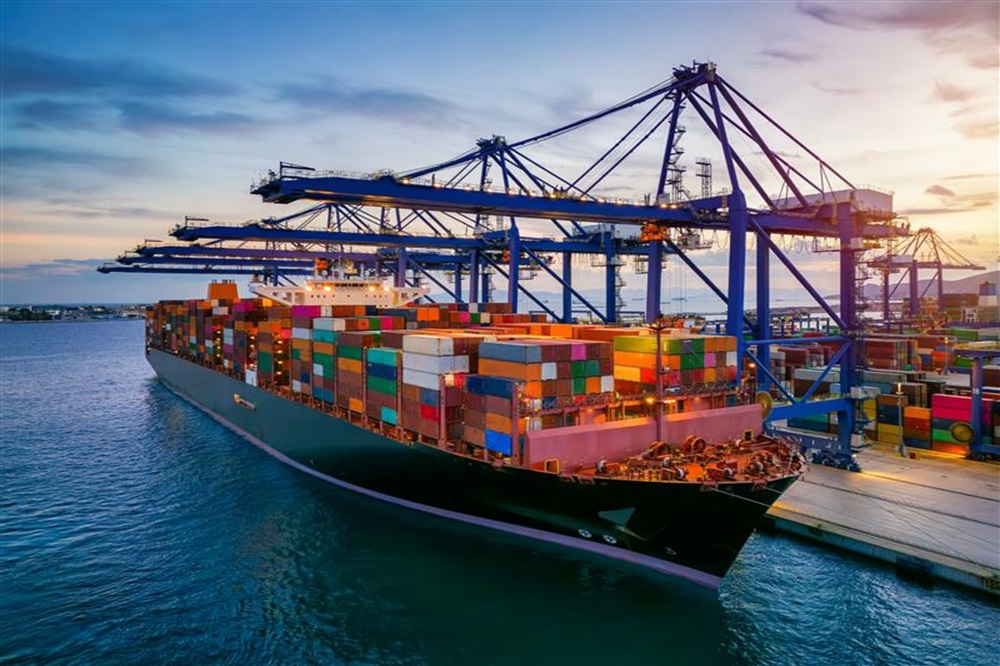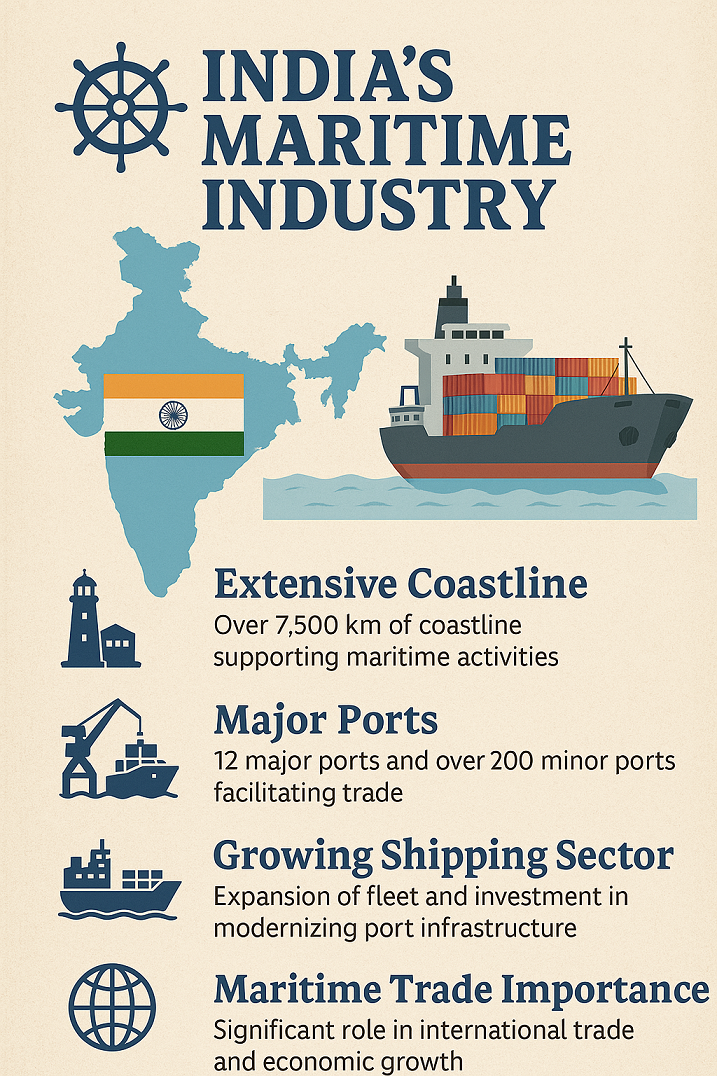Context:
In today’s world, connectivity plays a key role in global trade, diplomacy, and development. It allows the smooth movement of goods, services, money, people, and data across borders. This helps build strong supply chains, supports trade, and improves cooperation between countries.
- In the past, sea routes were used by colonial powers to move cheap raw materials from colonies and sell their finished goods in global markets. But now, developing countries like India, China, Vietnam, Thailand, and Malaysia are becoming new hubs for manufacturing and logistics. These countries are investing in better technology, improving delivery systems, and finding new ways to finance trade. As a result, global supply chains are shifting from the North (developed countries) to the South (developing countries).
- The World Bank says that developing nations now handle about 55% of global seaborne exports and 61% of imports, showing their growing role in global shipping.
Maritime Trade Trends and Port Significance:
As the lifeblood of the global economy, maritime trade connects markets, drives supply chains, and links producers with consumers across borders. Despite disruptions due to COVID-19 and growing geopolitical tensions, maritime activity is rebounding.
As per the United Nations Conference on Trade and Development (UNCTAD) 2024:
· Maritime trade grew by 2.4%, reaching 12.3 billion tonnes in 2023.
· It is projected to expand by 2% annually through 2029.
- Maritime transport handles more than 80% of international, regional, and intra-regional trade flows, making ports critical enablers of economic development. Ports serve as nodes of connectivity, facilitating trade, employment, industrial clustering, and infrastructure growth. The shipping industry currently moves about 11 billion tonnes of goods each year, and its contribution to global GDP, population well-being, and trade continues to grow.
- However, global shipping routes are facing rising uncertainties due to the Russia–Ukraine war, Red Sea disruptions, and Middle East conflicts. These have significantly impacted the cost and availability of energy and food supplies in many developing countries.
- One of the worst-affected regions is the Small Island Developing States (SIDS). UNCTAD reports that maritime connectivity for SIDS has declined by 9% over the past decade, making them ten times less connected to global trade networks compared to other regions. This underlines the vulnerability of maritime-reliant economies to geopolitical shocks.
About India’s Maritime Profile:
India, as a rising power in the Global South, holds a unique maritime advantage. It has:
· 9 out of 28 states with coastlines
· 1,382 islands within its territory
· An Exclusive Economic Zone (EEZ) spanning over 2 million square kilometres
India operates a fleet of 1,530 ships, and its port infrastructure includes 217 ports, of which 12 are major ports. Over the last decade, India’s port sector has recorded strong growth:
· Cargo traffic rose from 871.52 million tonnes in 2014–15 to 1,629.86 million tonnes in 2023–24
Specific port performance includes:
· Paradip Port earning US$ 188 million in revenue (2023–24)
· Jawaharlal Nehru Port achieving a net surplus of US$ 151 million
India’s Maritime Vision 2030 aims to transform port infrastructure as a backbone for economic development and global trade integration. The plan targets US$ 82 billion in investments by 2035 to upgrade port capacity, logistics, digitisation, and sustainability. Operationally, the average turnaround time at Indian ports has improved to 22.57 hours, reflecting growing efficiency.
Key Challenges in India’s Maritime Sector:
Despite progress, India’s maritime sector continues to face multiple challenges:
· Outdated infrastructure at many non-major ports
· Ageing fleet and limited indigenous shipbuilding capacity
· High shipbuilding costs and low domestic production of marine components
· Steep logistics and freight charges
· Lack of investments in sustainable shipping technology
· Significant skills gap, especially in high-tech port management
· Regulatory hurdles, including delays in land acquisition and coastal zone clearance
· High taxes and import duties, which disincentivise private sector participation
Digital Technologies and Smart Port Solutions:
Digitalisation is transforming global shipping. Technologies such as Artificial Intelligence (AI), Blockchain, Internet of Things (IoT), and Smart Port Infrastructure Management Systems (SPIMS) are driving higher efficiency and transparency in maritime operations.
In India, the Sagarmala initiative recognises port modernisation as a key pillar for reform. It aims to:
· Streamline regulations
· Improve port efficiency
· Lower logistics costs
· Enable smart, sustainable port operations
By collecting and using real-time data on container and vessel movements, Indian ports can reduce delays, increase throughput, and enhance last-mile connectivity. Adoption of shore power and green fuels further contributes to India’s environmental goals.
Workforce and Skills Development:
As ports and ships become smarter, India must address the critical shortage of skilled maritime professionals. Key areas of concern include:
· Container logistics management
· Vessel traffic services
· Terminal operations using digital systems
· Application of AI and IoT for maintenance and forecasting
India must invest in:
· Specialised training programs aligned with global standards
· Maritime education reform
· Industry-institute partnerships for hands-on training
Equipping the workforce with 21st-century skills is essential to operate modern port infrastructure and meet international benchmarks.
Environmental Regulations and Sustainable Financing:
The International Maritime Organisation (IMO) is set to adopt new net-zero regulations for shipping by October 2025, which will:
· Mandate cleaner fuels and lower emissions
· Introduce a global carbon pricing framework
· Require structural and operational changes in fleets and ports
India is expected to face compliance costs of US$ 8–10 million annually by 2030, resulting in a 14% rise in fuel costs and a 5% increase in freight rates. These costs could strain smaller operators and delay sectoral transition.
To address this, India has proposed a Maritime Development Fund (MDF) with a corpus of INR 25,000 crore (approx. US$ 3 billion) in the Union Budget 2024–25. However, this remains insufficient due to:
· Lack of tax incentives for green shipping
· High cost of imported components
· Shortage of structured debt, equity, or blended financing mechanisms
India must design a green financing roadmap, which includes:
· Tax breaks for retrofitting ships and adopting clean fuel
· Public-private partnerships for innovation and R&D
· Access to concessional loans, especially for smaller players
Conclusion:
India stands at a strategic juncture in global maritime affairs. Its geographical advantage, large EEZ, expanding economy, and port development plans make it a natural contender for leadership in the Indo-Pacific maritime domain.
To realise this potential, India must:
· Reform port governance and streamline regulation
· Upgrade its fleet and adopt sustainable technologies
· Develop a digitally competent maritime workforce
· Facilitate easier access to green and long-term capital
· Deepen regional cooperation and South–South maritime partnerships
By enhancing port performance, enabling digital innovation, and embedding sustainability in its maritime agenda, India can become a central player in building resilient global supply chains and inclusive ocean economies of the future.
| Main Question: India’s port infrastructure has seen significant growth in the last decade, yet structural bottlenecks remain. Discuss the key constraints faced by India’s shipping and port sector and suggest comprehensive reforms to improve maritime efficiency and global competitiveness. |








